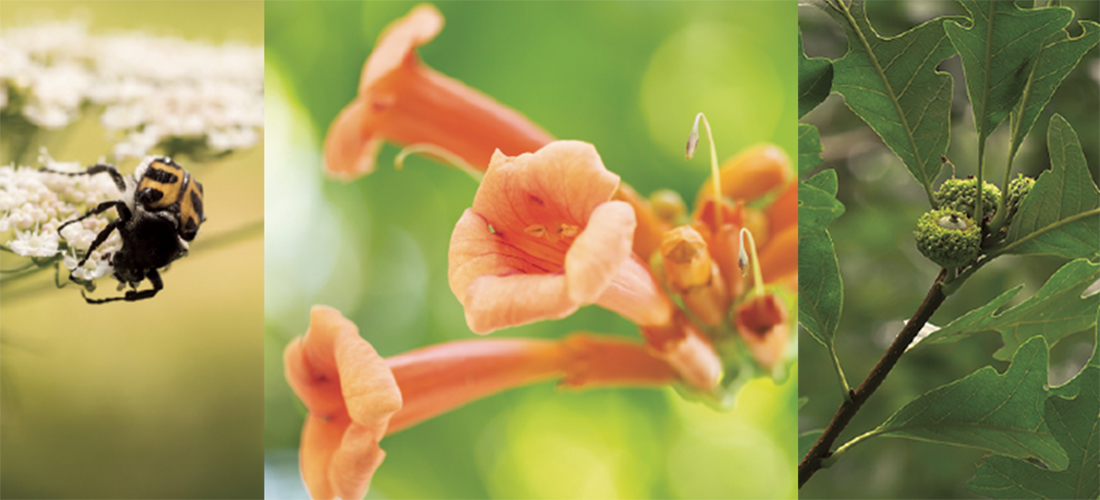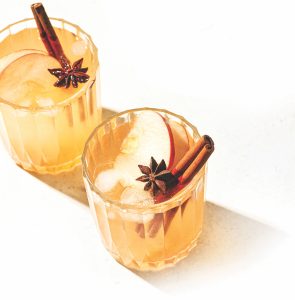
Choosing plants that promote biodiversity
By Jan Leitschuh
It’s the web of life, local-scale.
Outside our vegetable gardens — where it seems everything is trying to eat our tomatoes, cabbages and squash — it’s a potential desert out there for insect life, says a prominent naturalist. They don’t have enough to eat.
What, you say? Don’t care about bugs and crawlies? Good riddance?
Understandable, but quite shortsighted, says Dr. Douglas Tallamy, University of Delaware professor and chair of entomology and wildlife ecology. Birds, butterflies, amphibians and animals — and humans — all depend on the biodiversity of native plant communities. And without biodiversity, he says, “They are starving. Many bird species, for example, have declined drastically in the past 40 years.”
This bald fact has profound implications for the human race.
Tallamy is speaking at the Fair Barn in Pinehurst Oct. 30 on “Restoring Nature’s Relationships at Home,” sponsored by Save Our Sandhills. He wants you to know this: As we witness natural systems crashing around us, ordinary citizens are a critical piece of the puzzle going forward.
“It’s in our own self interest to care,” he says, and to care deeply. “We are literally supported by the natural systems that surround us. And the plants form the foundation for the web of life that surrounds us. It is biodiversity that runs the ecosystems that support us.” He pauses for emphasis, and then repeats: “We are supported by natural systems.”
In other words, there’s no more “out there” out there. We have to begin with our own residential landscapes.
Native Sandhills and North Carolina plants evolved in specific local weather, soil and terrain conditions; local bugs, animals and birds adapted right along with them.
We all know by now that native plants are naturally better adapted to a given area.
“Natives have proven themselves to be adapted to what Mother Nature provides in a particular area. They do not need the additional care that most imported plants do,” notes Dee Bartlett Johnson, coordinator at Sandhills Community College’s landscape gardening department. “ If we are trying to lessen our impact on the environment, natives are certainly the way to go; less water and less fertilization are needed.”
And there are even deeper reasons: life itself.
“By restoring natives to our landscapes, we are restoring life to our residential properties,” says Tallamy. We add back critical links in a fragmented habitat, habitat that is needed to restore balance to natural systems.
“There really aren’t enough natural areas anymore to support the biodiversity of life,” says Tallamy, “and those that do exist are chopped up and fragmented. By planting native species on our residential properties, we connect those habitat fragments, throw them a lifeline. Most people think nature is happy and healthy ‘somewhere else’ but there is no ‘somewhere else’ anymore.”
Native plants occupy essential spots in the local ecosystem. “They don’t call it an ecoSYSTEM for nothing,” says Tallamy. “It is a system. Nature, by its very nature, creates specialized relationships between plants and animals in a given area.”
It’s the cosmic dance of interaction and interdependence. The premise of Tallamy’s talk is simple: Native plants evolved in concert with local insects, birds and animals, thus native plants provide for their food and habitat needs better than plants from elsewhere.
Native species are necessary for insects and animals to thrive because they provide critical food and habitat for life. “We plant the beautiful ornamental from elsewhere because it is flashy, but the end result is local creatures are starving because they simply didn’t evolve with the new landscaping and can’t draw nourishment from them,” says Tallamy, also the author of Bringing Nature Home: How You Can Sustain Wildlife with Native Plants (Timber Press, $27.95).
“I’m not trying to recreate the ancient ecosystem,” he once said in an interview with The New York Times. “That is gone. I’m trying to create biodiversity.”
In an opinion piece in 2015, Tallamy wrote, “Plants are as close to biological miracles as a scientist could dare admit. After all, they allow us, and nearly every other species, to eat sunlight, by creating the nourishment that drives food webs on this planet. As if that weren’t enough, plants also produce oxygen, build topsoil and hold it in place, prevent floods, sequester carbon dioxide, buffer extreme weather and clean our water. Considering all this, you might think we gardeners would value plants for what they do. Instead, we value them for what they look like.”
According to a supporting website, BringingNatureHome.com, “Chances are, you have never thought of your garden — indeed, all of the space on your property — as a wildlife preserve that represents the last chance we have for sustaining plants and animals that were once common throughout the U.S. But that is exactly the role our suburban landscapes are now playing and will play even more in the near future.
“If this is news to you, it’s not your fault. We were taught from childhood that gardens are for beauty; they are a chance to express our artistic talents, to have fun with and relax in. And, whether we like it or not, the way we landscape our properties is taken by our neighbors as a statement of our wealth and social status.
“But no one has taught us that we have forced the plants and animals that evolved in North America (our nation’s biodiversity) to depend more and more on human-dominated landscapes for their continued existence.”
For example, oak trees are a tree species that support an enormous spectrum of biodiversity. “But there are no more woods, not like before,” Tallamy says. “We now find those productive oak trees in our front yards, lining our neighborhoods. By planting native plants, we connect those habitat fragments.”
In a geological age so dominated by humanity’s impact on the environment that scientists have recently labeled it the Anthropocene Era, we find that almost 50 percent of the land mass has been transformed by human action. “Our actions have impact,” Tallamy says. “And resolution can begin at home.
“What we’ve done is recognize that plants are pretty. So all these human-dominated ecosystems are going to be decorated with pretty plants. That’s fine in itself, but they often come from somewhere else, often Asia/China.
“Our native ecosystems don’t run on these non-native plants. Native plants, on the other hand, take sun and pass that energy on as food. Insects and other life eat them. These non-native plants are inedible to most insect species here, so they’re not passing their energy on.”
Many of these non-native plants have escaped our gardens and become invasive weed species in nature habitats. Tallamy says that 30 percent of the U.S. plant biomass is now from Asia. “Our natural areas are invaded,” he says.
Most birds rear their young on caterpillars. “It takes 6,000 to 9,000 caterpillars to raise a brood of chickadees. Look at the tiny space of habitat for all those birds crammed in there, 70 to 80 percent in human created areas,” Tallamy says.
“I compared a young white oak in my yard with one of the Bradford pears in my neighbor’s yard,” he wrote. “Both trees are the same size, but Bradford pears are ornamentals from Asia, while white oaks are native to eastern North America. I walked around each tree and counted the caterpillars on their leaves at head height. I found 410 caterpillars on the white oak (comprising 19 different species), and only one caterpillar (an inchworm) on the Bradford pear.”
Tallamy and his wife spend their free time clearing their acreage of autumn olive, burning bush, bush honeysuckle, barberry, miscanthus ornamental grass and other non-native invasives. “It’s a very long list,” says Tallamy. “There are a few key genera of plants that produce about 75 percent of the food. Planting native oaks as a street tree, for example. They support 557 types of caterpillars versus the imported zelkova, which supports zero species of caterpillars. So, if you’re a chickadee, we need a few powerful genera. We can have that crape myrtle, it’s noninvasive — but if it’s all crape myrtle, we’re in trouble.”
Native plantings need not be boring, says SCC’s Johnson. “Many of our natives have amazing blooms,” she says, “but beyond that many of them have year-round interest such as interesting foliage, wonderful fall color and interesting branch structure in the winter. Azaleas will not give you those kinds of interest, and they will be a lot more work than the natives.”
Lawn is unhelpful, notes Tallamy. “It doesn’t sequester carbon, doesn’t help support food webs, or support water systems,” he says. His proposal? “ Let’s cut lawn areas in half. If we all did that, we’d have a new, homegrown national park, 20 million acres in size, scattered all over the place.
“Planting natives is fun, it exposes the kids to nature, and most of all it recognizes that everybody on this planet has a stewardship role. Because it’s the only place we’ve got.”
Three of the top six invasive, non-native plants mentioned by the Smithsonian Insider website include:
Japanese honeysuckle (Lonicera japonica) vs. alternative natives such as Trumpet creeper (Campsis radicans) and coral honeysuckle (Lonicera sempervirens).
Japanese barberry (Berberis Thunbergii) vs alternative natives such as Shrubby St. Johnswort (Hypericum prolificum) and winterberry (Ilex verticillata).
English ivy (Hedera helix) vs. alternative natives such as creeping mint (Meehania cordata), Allegheny spurge (Pachysandra procumbens) and creeping phlox (Phlox stolonifera).
In the vegetable and flower garden, says Taylor Williams, Moore County Cooperative Extension, gardeners may wish to include caterpillar-feeding members of the fennel (Apiaceae) family, including dill, fennel, coriander, etc. Also, all members of the mint family, including basil, lavender, oregano, thyme, bee balms and more in addition to many members of the aster family, especially goldenrods and yarrow, sunflowers, rudbeckia, and Indian blanket. PS
Dr. Douglas Tallamy’s talk is at 2 p.m., Oct. 30, at the Fair Barn, 200 Beulah Hill Road S., Pinehurst, NC 28374. Admission is free but registration is required. Call 910-295-1900 or register online at www.surveymonkey.com/r/Tallamy.
Jan Leitschuh is a local gardener, avid eater of fresh produce and co-founder of the Sandhills Farm to Table Cooperative.





